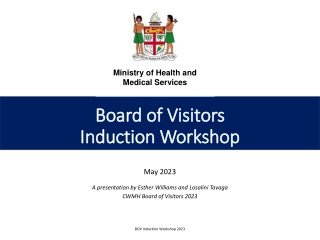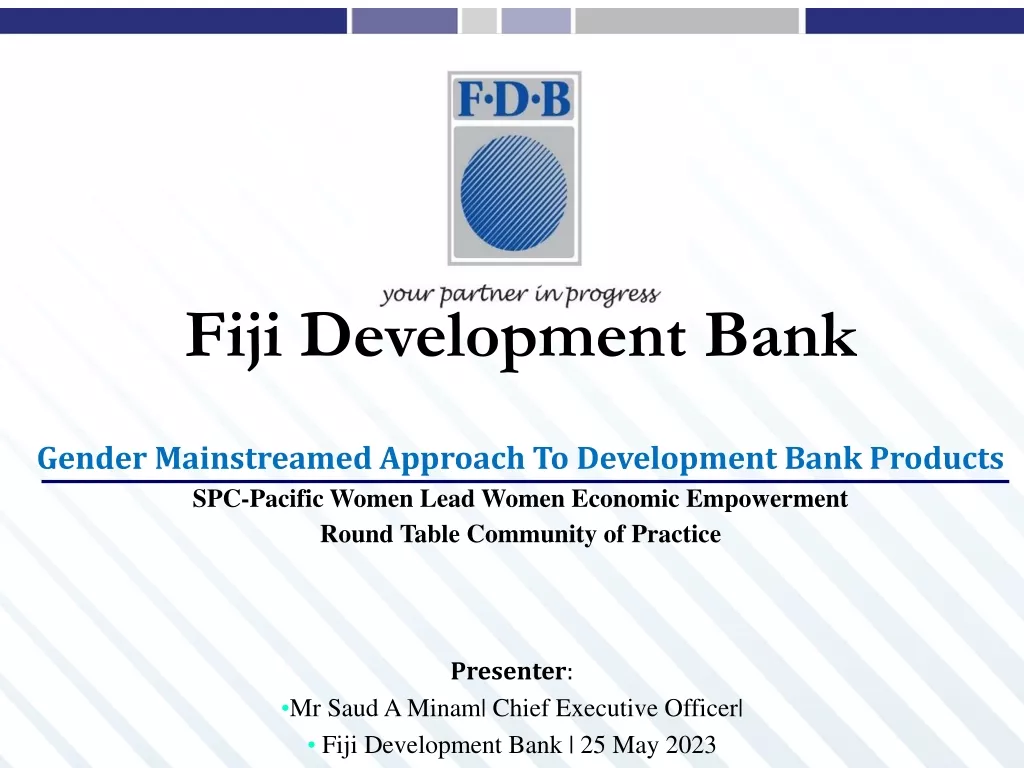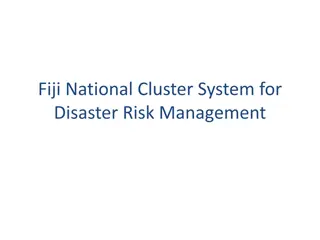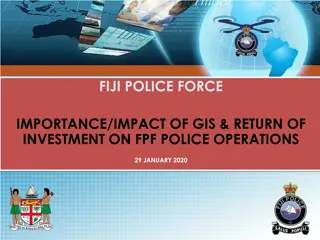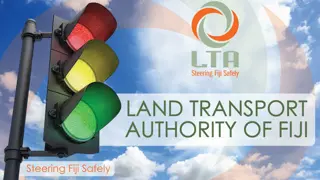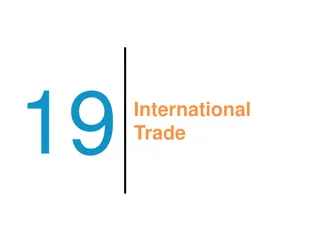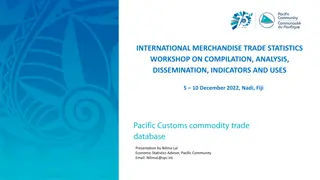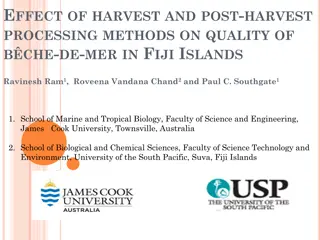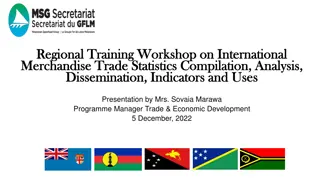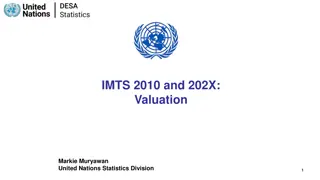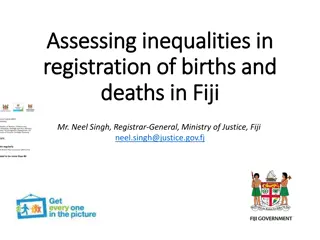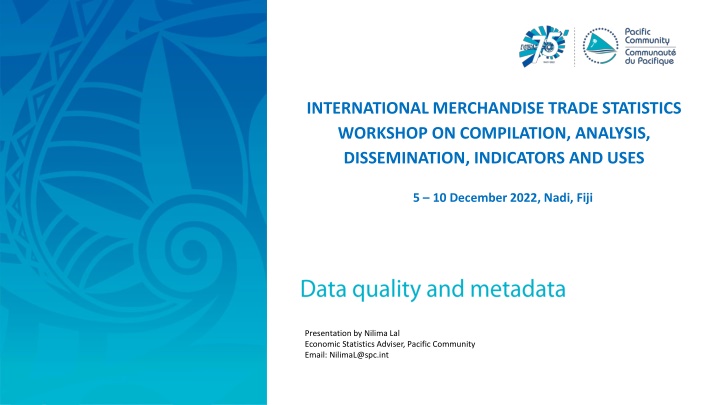
International Merchandise Trade Statistics Workshop in Fiji
Presentation on data quality, metadata, and enhancement in IMTS, focusing on validation, institutional arrangements, technology use, dimensions of quality, and quality measures with indicators.
Download Presentation

Please find below an Image/Link to download the presentation.
The content on the website is provided AS IS for your information and personal use only. It may not be sold, licensed, or shared on other websites without obtaining consent from the author. If you encounter any issues during the download, it is possible that the publisher has removed the file from their server.
You are allowed to download the files provided on this website for personal or commercial use, subject to the condition that they are used lawfully. All files are the property of their respective owners.
The content on the website is provided AS IS for your information and personal use only. It may not be sold, licensed, or shared on other websites without obtaining consent from the author.
E N D
Presentation Transcript
INTERNATIONAL MERCHANDISE TRADE STATISTICS WORKSHOP ON COMPILATION, ANALYSIS, DISSEMINATION, INDICATORS AND USES 5 10 December 2022, Nadi, Fiji Presentation by Nilima Lal Economic Statistics Adviser, Pacific Community Email: NilimaL@spc.int
Data quality and metadata Data quality measurement IMTS is the product of a complex process: collection-compilation- analysis-dissemination The objective of data quality measurement is to - to provide producers with the appropriate information to monitor and further enhance data quality, and to provide users with sufficient information to judge whether the data are fit for use for their intended purpose. 2
Enhancing the quality of IMTS Enhancing data quality is a process covering all stages of the statistical production process. It should not only focus on individual elements of data (such as commodity, value, quantity, unit of quantity and trading partner) but must also address more general issues of coverage and comprehensiveness of recording. Enhancing data quality - begins with the validation of the data provided by the trader or broker when completing the customs declaration/SAD. requires appropriate institutional arrangements to allow adequate access to different data sources. This is particularly important for those PICTs where data on the re-exports of fuel have to be sourced from business enterprises as these are not available in the customs records. also implies the appropriate use of information and communication technology. 3
Quality dimension of IMTS Most international organisations and many countries have developed definitions of quality, outlining the various dimensions of quality and quality measurement, and have integrated them into quality assessment frameworks. Examples: United Nations National Quality Assurance Framework (UN NQAF) The IMF Data Quality Assessment Framework (DQAF) The dimensions of quality are overlapping and interconnected. Actions taken to address or modify one aspect of quality will tend to affect other aspects. 4
Quality measures and indicators Quality measures directly reflect a particular aspect of quality, such as the time lag from the end of the reference period to the release of IMTS. However, in practice, quality measures can be difficult or costly to calculate. Instead, quality indicators may be used for the quality assessment. Quality dimension Quality measure and indicator Number and degrees of divergence from the relevant international statistical standards in concepts and measurement procedures that are used in the collection and compilation of IMTS (preferably in terms of the amount of data affected). Methodological soundness Accessibility Number and types of means used for dissemination of IMTS. Degree to which all detailed data sets are made available, as a percentage of total IMTS data sets produced. Dissemination of complete metadata used. Relevance Gaps between key user interests and IMTS in terms of concepts, coverage and detail. Results of users satisfaction surveys and meetings with user groups. 5
Quality measures and indicators cont. Quality dimension Quality measure and indicator Data source is the NSO which is the official source for data on IMTS. Application of reporting thresholds. Under coverage (percentage of non-reporting due to thresholds, percentage of non- reporting due to non-response). Characteristics and frequency of revisions (such as percentage of total value). Application of confidentiality and its impact. Use of data validation techniques and their impact. In the case of sample surveys-based IMTS estimates, the accuracy can be measured using Sampling errors and Non-sampling errors. Number and average size of revisions of international merchandise trade data. Time lag between the end of the reference period and the date of the first release (or the release of final results) of IMTS. Credibility Accuracy Timeliness Use of common concepts, classifications, data sources and methods. Availability of appropriate bridging tables. Coherence User is able to understand and use the data with ease. Interpretability 6
Cross-country data comparability Countries are encouraged to periodically conduct bilateral and multilateral reconciliation studies so that their statistics can be made more accurate and useful. valuation, including CIF/FOB differences time lags in reporting currency conversion Non-comparability of data between countries is caused by differences in different methods for the treatment of certain goods (such as military goods, ship s stores, confidential data) trade via third country intermediaries classification of goods 7
Metadata on IMTS Microdata Macrodata Metadata Refers to data on the characteristics of individual transactions collected by customs or other sources Macrodata is data derived from microdata by grouping or aggregating them e.g. total exports Metadata is data about data e.g. who has created the data how data were collected PICTs shouldincludethe followingmetadata categories for theirIMTS. A description of all underlying concepts and definitions, including the trade system used and deviations from international standards, if any. The legal framework, institutional arrangements and description of data sources. A description of data-collection and data-processing procedures. A description of estimation methods. A data-dissemination policy, including release and revision schedules. A description of all data fields/variables: including reference period, trade flow, commodity classification used, valuation, currency, quantity (net weight), weight unit used, partner country (origin, last known destination, consignment). Explanations and footnotes concerning the data, as required, such as informing users about revisions, break in series and application of confidentiality. Quality reporting. 8
Recommendations Recommendations Data quality It is recommended that PICTs develop standards related to good practices covering institutional arrangements, statistical processes and outputs. Further, it is recommended that PICTs develop a standard for regular quality reports using the standards related to good practices as its basis. The quality reports should comprise both quantitative and qualitative indicators for IMTS, as well as a checklist covering data collection, processing and dissemination in order to assess the strengths and weaknesses in the statistical process and to identify possible quality-improvement actions as well as keep users informed on the methodology. Metadata It is recommended that PICTs view the development of metadata as a high priority and consider their dissemination an integral part of the dissemination of IMTS. 9
Thank you 10


